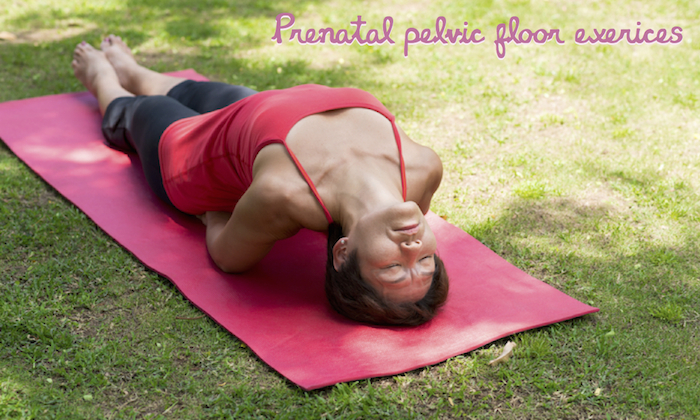

Tighten your muscles mama and give these prenatal pelvic floor exercise a go!
Are you always rushing to find the loo? Have a real urgency that ‘when you gotta go, you gotta go’ or even more inconveniently, suffer from urine leakage on sudden exertion, coughing or sneezing? As your pregnancy develops are these problems worsening? These can all be signs that your pelvic floor muscles are not doing their job properly. The pelvic floor muscles act as a sling from the pubic bone to the sacrum at the bottom of the spine. They support the uterus and bladder and need to be in good shape to prevent the problems mentioned above from happening. The term continence is used to describe the ability to control bladder and bowel actions that are in turn dependant on pelvic floor muscle activity. If you are unable to fully control these functions then the term incontinence applies.
The importance of women being informed and aware of their pelvic floor and its function cannot be underestimated. Pregnancy and immediate post pregnancy are often the most vulnerable times for pelvic pain and continence issues to arise and left untreated can become more problematic with age. Continence can also be influenced by varying hormone levels, recurrent urinary trace infections, chronic cough, constipation, low back pain, being overweight, and by constant lifting either in your workplace or the home where small children often need lifting.
One in three women suffer from incontinence at some stage of their adult life. This is a worrying statistic but the good news is that it can be prevented and where it is already happening, can in almost all cases be cured with a good education and training approach.
Leading up to a planned pregnancy and during early pregnancy is an ideal time to make sure your pelvic floor muscles are healthy and working optimally. Physiotherapists and in particular those specializing in Women’s Health are well placed to help women understand pelvic floor function and to give advice and treatment when pelvic floor problems and continence issues already exist. So, give these prenatal pelvic floor exercises a try!
Multifunctional Pelvic Floor:
The focus on the pelvic floor in current popular literature is more often than not specifically focused on continence issues, but it is important to realize that the pelvic floor muscles are multifunctional. They play an integral part in
- Control of bladder and bowel function
- Supporting abdominal organs
- Healthy and enjoyable sexual function
- Providing structural support to the hips, spinal and pelvic joints
So if the pelvic floor muscles are weak and not functioning well, then the implications are many.
- Continence issues
- pelvic organ prolapse (POP)
- reduced sexual function and pleasure
- hip, spinal and pelvic pain and dysfunction
These are just some of the potential problems that may arise. This all sounds very gloomy but most symptoms as mentioned are firstly preventable, and secondly treatable and curable, using simple education and training strategies.
During pregnancy the pelvic floor muscles are put under more strain than usual as they help to support the extra weight of the baby in utero. It is very important to keep these muscles in good shape during pregnancy and to continue good pelvic floor care at all times. The effect of hormones, fatigue levels as well as the increasing weight of the baby can challenge any expectant mothers ability to be able to totally control bladder function, be free of joint pain and to not feel pelvic muscle fatigue particularly after a busy day.
As soon as pregnancy is confirmed it is important to start an exercise program and to stick with it.


Exercising the Pelvic Floor.
Having stronger healthier muscles allows for a more comfortable pregnancy. Healthy muscles are resilient, stretch more effectively during delivery and rebound more quickly post delivery.
To exercise effectively you need to be aware of your pelvic floor muscles, where they are, how they function and what they look like. Become familiar with your perineum by using a mirror and digital palpation. Have some anatomical style pictures available when you do this and observe the movement of the vaginal opening and the anus when attempting a pelvic floor contraction.
Are they lifting up or bearing down? You want them to be lifted on contraction away from the mirror. Unfortunately it is quite common for women to bear down when they think they are lifting hence the importance of observation during this activity.
Try tightening your pelvic floor muscles around your fingers while inserted in the vaginal opening. You may wish to wear a sterile glove but there is no need, simply washing your hands well is enough. Vaginas are not sterile environments.
The pelvic floor muscles are made up of two different types of muscle fibres: slow twitch and fast twitch. It is important to incorporate exercises that activate both types of fibres.
DO NOT use ‘stopping urine flow’ as an exercise. This action is intended as a test only.


A simple program of contract relax exercises done regularly is the best approach, incorporating both slow hold relax and fast twitch response techniques. It is important not to overdo the exercises as pelvic floor muscles tire easily. Short bursts often are a more sensible approach. Each individual will vary though so it is important to consult with your physiotherapist.
A good resource to consult for more information is www.PelvicExercises.com.au. Michelle Kenway is an Australian Pelvic Floor Physiotherapist and she gives great advice to help understand your pelvic floor function and how to exercise the muscles appropriately.
But for a full and comprehensive education session it is best to consult your physiotherapist and is essential if you already have some existing problems.
To add to the enjoyment of your pregnancy and to bounce back into shape more easily get in touch with your pelvic floor muscles and exercise them regularly. Finally, follow these tips to supplement a daily exercise regime:
- Drinking enough fluid
- Minimizing coffee, tea and drinks with stimulants
- Moderate alcohol intake
- Healthy weight range
- Avoid constipation
- Treat chronic coughs
- Long-term exercise plan
 View All
View All


 View All
View All


 View All
View All

 View All
View All
 View All
View All


 View All
View All








